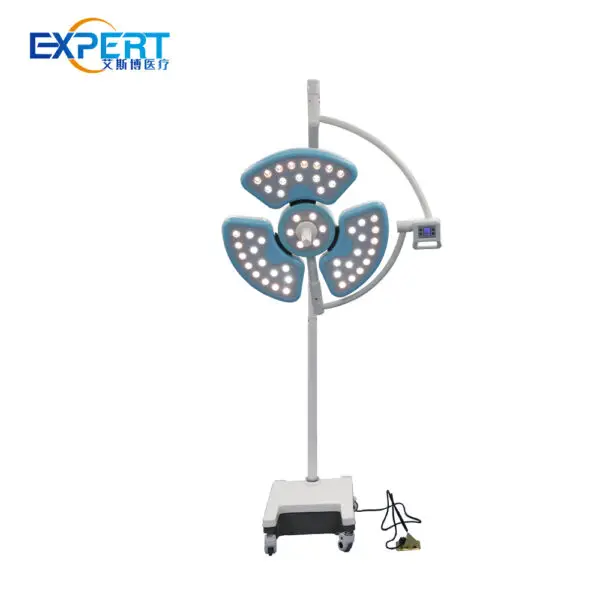عنوان
304 شارع الكاردينال الشمالي
مركز دورتشستر ، ماساتشوستس 02124
ساعات العمل
من الاثنين إلى الجمعة: 7 صباحًا - 7 مساءً
عطلة نهاية الأسبوع: 10 صباحًا - 5 مساءً
عنوان
304 شارع الكاردينال الشمالي
مركز دورتشستر ، ماساتشوستس 02124
ساعات العمل
من الاثنين إلى الجمعة: 7 صباحًا - 7 مساءً
عطلة نهاية الأسبوع: 10 صباحًا - 5 مساءً

في عالم الجراحة، كل تفصيل مهم. من بين العوامل العديدة المؤثرة على نتائج الجراحة، تلعب مصابيح العمليات دورًا حاسمًا، وإن كان غالبًا ما يُغفل. تهدف هذه المدونة إلى التعمق في أهمية مصابيح العمليات الجراحية، وإلقاء الضوء على تأثيرها وأهميتها.

في عالم الجراحة، كل تفصيل مهم. من بين العوامل العديدة المؤثرة على نتائج الجراحة، تلعب مصابيح العمليات دورًا حاسمًا، وإن كان غالبًا ما يُغفل. تهدف هذه المدونة إلى التعمق في أهمية مصابيح العمليات الجراحية، وإلقاء الضوء على تأثيرها وأهميتها.
Operating lamps serve as the primary source of illumination in the operating room, illuminating the surgical field and enabling surgeons to perform intricate procedures with accuracy and confidence. Their significance cannot be overstated, as they contribute directly to the success and safety of surgical interventions.
The quality and adequacy of lighting provided by operating lights are crucial factors that influence every aspect of surgery, from initial incision to wound closure. Optimal lighting conditions facilitate clear visualization of anatomical structures, vital tissues, and surgical instruments, allowing surgeons to navigate complex procedures with ease.
Moreover, effective lighting minimizes the occurrence of shadows, which can obscure critical details and impede the surgeon’s ability to perform precise maneuvers. By eliminating shadows, operating lights ensure consistent and uniform illumination throughout the surgical field, enhancing visibility and reducing the risk of errors.
Accurate tissue differentiation is another essential function facilitated by operating lights. By providing the right balance of brightness and color temperature, these lights enable surgeons to distinguish between various types of tissue, such as blood vessels, nerves, and organs. This differentiation is crucial for identifying and preserving delicate structures while performing intricate surgical maneuvers.
Furthermore, operating lamps play a significant role in reducing eye strain and fatigue among surgical team members. Prolonged periods of intense concentration under inadequate lighting can lead to visual fatigue and decreased performance. High-quality operating lights with adjustable brightness and ergonomic design help mitigate these effects, ensuring that the surgical team remains alert and focused throughout the procedure.
Over the years, operating lamp technology has evolved significantly to meet the evolving needs of modern surgery. From traditional incandescent lights to advanced LED and xenon-based systems, the quest for superior illumination has driven innovation in operating light design. These advancements have not only improved brightness and color rendering but also minimized heat generation and energy consumption, enhancing both efficiency and patient safety.









The quality of operating lamps can profoundly influence surgical performance and patient outcomes. Inadequate lighting can impede visibility, increase the risk of errors, and prolong surgical durations. Conversely, optimal lighting conditions contribute to better visualization, precision, and procedural efficiency. Therefore, investing in high-quality operating lights is essential for ensuring optimal surgical outcomes.
To further elucidate the importance of operating lights, let’s examine a few case studies highlighting their impact on surgical outcomes:

| دراسة الحالة | Findings |
|---|---|
| Study 1 | Improved visualization with LED operating lamps led to a significant decrease in surgical complications. |
| Study 2 | Surgeons reported higher satisfaction and reduced fatigue when using advanced operating light systems. |
| Study 3 | Enhanced color rendering of xenon-based lamps resulted in better tissue differentiation and reduced reoperation rates. |
These studies underscore the critical role of operating lights in shaping surgical outcomes and patient safety.
Operating lamps are indispensable tools in the surgical setting, influencing visibility, precision, and overall procedural success. As technology continues to advance, investing in high-quality lighting solutions becomes increasingly crucial. By understanding and optimizing the impact of operating lamps, healthcare providers can enhance patient care and improve surgical outcomes.
س: لماذا؟ operating lamps important in surgery?
A:Operating lamps provide illumination, enabling surgeons to visualize the surgical field with clarity and precision, which is essential for successful procedures.
Q:What are the key factors to consider when choosing operating lights?
A:Factors such as brightness, color rendering, energy efficiency, and heat generation are crucial when selecting operating lights for surgical use.
س: كيف افعل operating lamps contribute to patient safety?
A:Optimal lighting conditions provided by operating lamps enhance visibility and reduce the risk of errors, ultimately improving patient safety during surgical procedures.
Q:Are there any specific guidelines for the use of operating lights in surgery?
A:While guidelines may vary, healthcare facilities should adhere to recommendations regarding lighting standards and maintenance to ensure optimal performance and safety.
Q:What advancements can we expect in مصباح التشغيل technology in the future?
A:Future advancements may focus on further improving energy efficiency, integrating advanced imaging technologies, and enhancing user interfaces to streamline surgical workflows and enhance patient outcomes.